Are predatory insects plaguing your garden?
While there are many types of beneficial nematodes, insecticidal ones are naturally occurring microscopic organisms that live and feed on insects in the soil.
There are different types of nematodes that kill insects. However, many of them are difficult to mass produce or have very narrow host ranges.
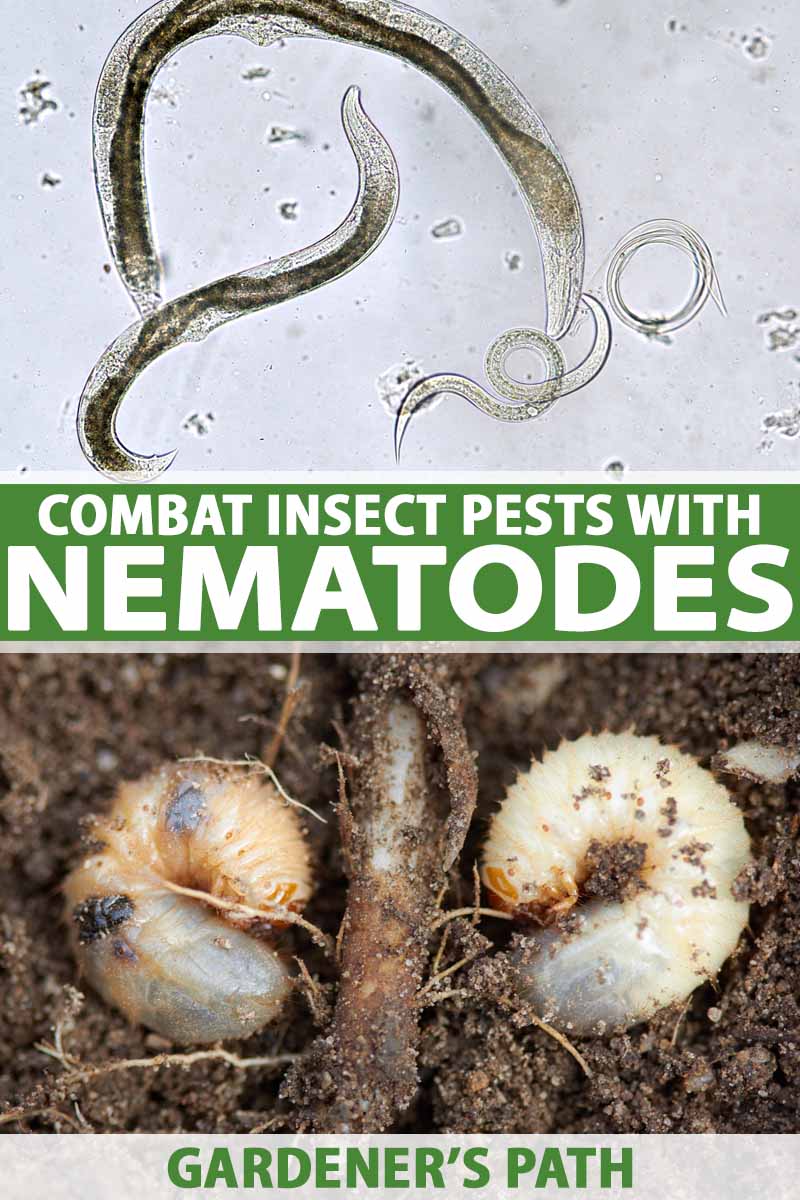
We link to vendors to help you find relevant products. If you buy from one of our links, we may earn a commission.
The beneficial nematodes that we will talk about here are entomopathogenic. This term derives from the Greek word entomon, or insect, and pathogenic, or disease-causing.
What makes these insect-killing nematodes special is that they kill their hosts quickly, due to special bacteria that live in their systems.
In contrast to the nematodes you are probably used to thinking of that parasitize plants and animals, these beneficial types can be a great help to your garden.
And in a wonderful gift from nature, insecticidal nematodes will kill pests that feed on plants while typically ignoring beneficial insects.
These fascinating organisms can help control up to 200 different species of insects from 100 different families. That’s pretty wide-ranging coverage.
Here’s what’s to come in this article:
What You’ll Learn
- Different Types and Behavior
- Identification, Biology, Distribution, and Life Cycle
- Nematode Prey
- Choosing the Right Nematode for Your Climate
- Benefits
- Application and Use
- Where to Buy
- Get Growing with Nematodes
Let’s talk more about what they are before we get into how you can use them, and where to buy them.
Beneficial nematodes offer a safe form of organic pest control for use in the garden. So safe, in fact, that the Environmental Protection Agency (EPA) even waived the need for them to be registered for pest management.
Not only are they safe for use around pets and people, they are ideal for treatment of soils like those around drinking wells that are sensitive to traditional pesticides.
Unlike chemical pesticides, and even the biopesticide Bt, you don’t need to use any special equipment or even a mask to apply these creatures to your garden.
And you can use your existing equipment – hoses and sprayers are no problem for them.
Different Types and Behavior
There are two genera of nematodes that are popular as marketable products to protect your garden.
The first genus is Steinernema – the most commonly sold genus for insect protection.
The second genus, Heterorhabditis, is more difficult to produce for commercial sale. However, these species are highly effective for eradicating insects that live deeper in the soil, particularly grub worms.
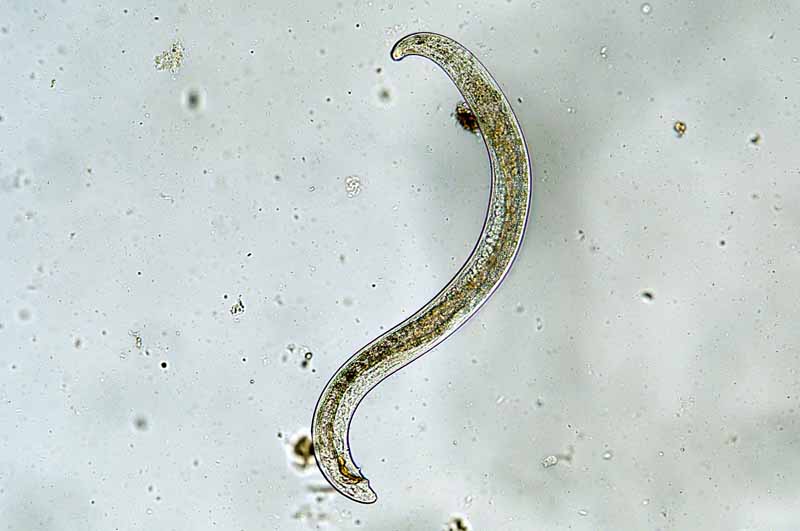
They are fascinating little organisms that go through six stages of life.
First is the egg stage. Next, they go through four juvenile stages before finally reaching the adult stage.
Those in the third juvenile stage, known as “infective juveniles” (IJ), or sometimes dauers, are the most resistant to environmental stress.
This is the only stage in their life cycle in which they will seek out insects to kill, and boy are they active!
Some sit and wait for prey to pass by. These types are known as “ambushers,” and are particularly effective against insects that move around in the soil. An example is S. carpocapsae.
Some species of Steinernema jump to attack their prey – sometimes up to nine times the length of their bodies!
The other types are known as “cruisers” because they are highly active and can move long distances to find their prey underground.
H. bacteriophora is a cruiser. This behavior makes it highly effective against pests like white grubs that don’t move around much.
Some species, such as S. feltiae and S. riobrave, combine the two types of behaviors.
Nematodes travel via water between particles of soil and identify their prey by monitoring changes in the carbon dioxide levels, temperature variation, and sometimes by excrement trails.
Once the prey is identified, it enters the chosen insect through a natural opening in its body like the mouth, anus, or spiracles (openings that are used to exhale carbon dioxide).
Species in the genus Heterorhabditis can actually penetrate the body of an insect through the cuticle if there are no other options to enter their prey.
You’ve probably noticed that these guys are pretty aggressive. Once inside, the different species behave in basically the same manner.
They release a strain of bacteria that lives inside their digestive system. These bacteria will rapidly multiply and kill the insect within 24 to 48 hours.
The different types each carry their own special bacteria – Xenorhabdus for Steinernema and Photorhabdus for Heterorhabditis.
The interactions between the nematodes and their bacteria are symbiotic, meaning each organism helps the other out.
The nematodes locate and enter the host, providing a home for the bacteria. In exchange, the bacteria weaken the insect’s immune system. And they produce chemicals that kill the insect as well.
Another thing that the bacteria do is release chemicals that are toxic to other microbes. This ensures that the nematodes can stay in their new home full of nutrient-rich food without having to fight off foreign invaders.
Steinernema species need both male and female nematodes to reproduce, while those of Heterorhabditis are hermaphroditic and produce offspring solely through females who have both male and female reproductive organs.
Once the nematode is inside its insect host’s body, it begins to reproduce. The babies thrive and grow by eating the nourishing tissue of the host insect and the dead bacteria.
When the insides of the host insect have been consumed and fully utilized, hundreds of thousands of nematodes in their juvenile stage emerge and begin hunting for their next meal.
If you have introduced beneficial nematodes in your garden, you can see if they are being effective by digging through the soil to look for grubs. You want to find grubs that are discolored.
Insects attacked by Heterorhabditis are usually orange-red, while those parasitized by Steinernema are typically cream to dark brown.
The reason these insects produce such odd colors is due to remnants of the pigments from the bacteria that grew inside them.
This may seem weird, but you should also smell the dead insects. They should not have a putrid smell. If they do, that means they were killed by other types of nematodes in the soil, and not the ones you introduced.
Identification, Biology, Distribution, and Life Cycle
Nematodes are usually between 0.6 and two millimeters long, with a cylindrical shape and an unsegmented roundworm body.
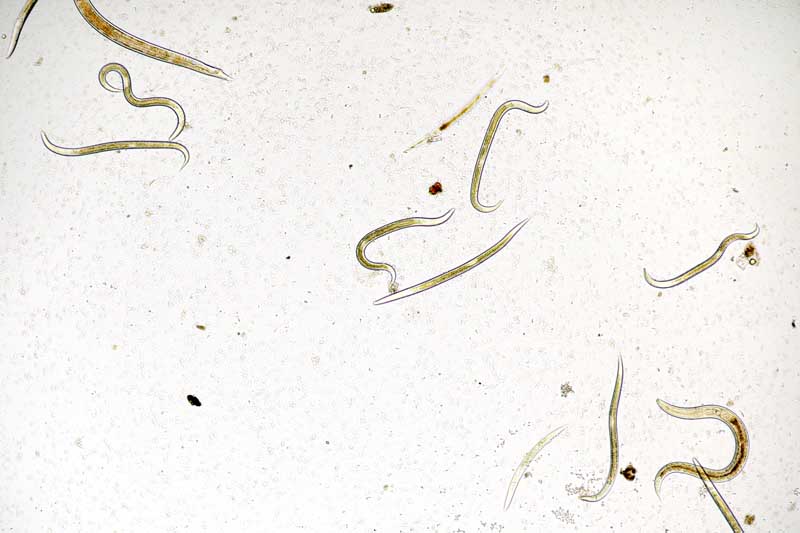
Steinernema includes the more shallow-dwelling, less mobile types, while Heterorhabditis species are more mobile, moving and hunting up to seven inches deep in the soil.
It’s important to remember that they move by traveling in the water in the spaces between particles of soil. They often move more effectively in sandy soils compared to clay because the pores in the soil are larger.
Free water is critical to the efficacy of your beneficial nematode attack plan! Irrigating before you apply will help them to control pests for a number of reasons:
- The pest grubs will move higher in the soil when it is wet – so it will be easier for the nematodes to attack them.
- Watering will lower the soil temperature.
- If the nematodes are trapped in tight thatch, watering may help them move down through the thatch.
Next, let’s take a look at the insect pests that these organisms target.
Nematode Prey
The two species of Steinernema most commonly used in pest treatment include S. feltiae and S. carpocapsae. These types attack insects that are closer to the surface of the soil, hunting to a depth of about three inches.
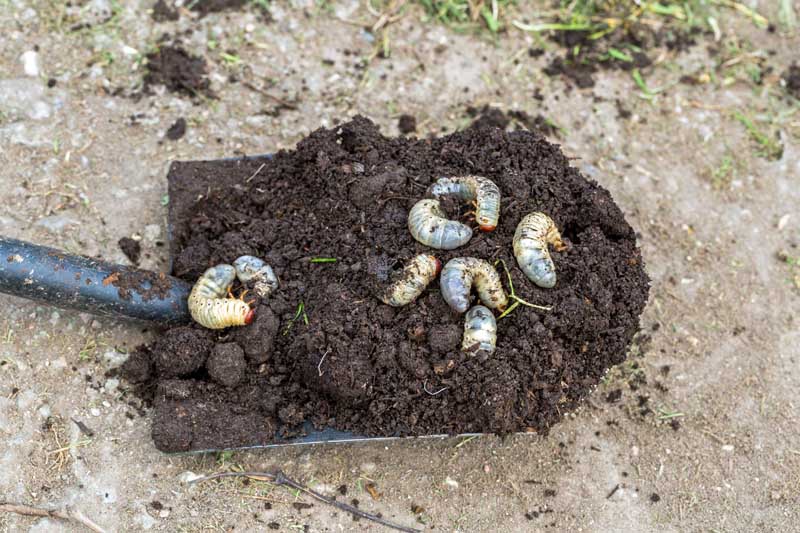
S. feltiae is highly effective at controlling pests like fungus gnats and fly larvae, and it will also parasitize some types of caterpillar larvae. This species acts most effectively in clay or silt soils.
S. carpocapsae attacks mobile insects, so it acts as an excellent tool for controlling caterpillar larvae. These prey include such voracious pests as cutworms, armyworms, and webworms.
S. carpocapsae is particularly useful against insects on the surface of the soil, which is where the Lepidopteran pests tend to be. It is most effective in sandy soils.
S. riobrave is another commercially available species in this genus. It has an unusually wide host range that spans different orders of insects and is usually sold to control weevils and mole crickets. This species combines the characteristics of an ambusher and a cruiser.
Two species of Heterorhabditis are also commercially available, and neither of these species is fussy about soil type. Since these nematodes pursue pests so deeply in the ground, they are used to control grubs like those of the Japanese beetle that live deeper in the soil.
H. bacteriophora is very versatile in its choice of host. It can attack both caterpillar and beetle larvae. It is also highly effective against root weevils.
The other Heterorhabditis species that is commonly sold is H. indica. This species will also attack a range of insects, including caterpillars and beetle larvae, weevils, fungus gnats, and thrips.
Choosing the Right Nematode for Your Climate
While you want to choose the right species to control the particular pest you are dealing with, you also need to consider the temperature of your soil during the growing season.
Some prefer hot weather, while others are effective at lower temperatures.
Those in the genus Heterorhabditis are fans of hot weather. H. indica is particularly heat tolerant and can parasitize insects when the soil temperature is 86°F or even higher.
H. bacteriophora is also a warm-temperature species and is much less effective at soil temperatures less than 68°F.
Species of the genus Steinernema vary in their temperature preferences. S. riobrave is active in a wide range of temperatures, from 59 to 95°F.
Originally isolated in the Rio Grande Valley in Texas, this species can even tolerate semi-arid conditions.
S. feltiae is unique among the insecticidal nematodes that are commonly used because it is active at temperatures as low as 50°F.
In contrast, S. carpocapsae is the most effective at soil temps between 72 and 82°F.
Benefits
One reality of selecting nematodes for pest control is that their action is not immediate, although it is quite effective over time. The first host insects will begin to die after 24 to 48 hours of application.
We have to be realistic about the behavior and timeline of these beneficial creatures. Now that they have infiltrated their insect hosts, they are feeding and reproducing, preparing the next generation.
They will continue to hunt and stay active unless they run out of food, or the temperature gets too hot or cold for them. As with any organic management practice, you should scout and pay close attention to detail.
Don’t be afraid to get your hands dirty.
Spend some time digging in your garden, looking for infected grubs and larvae. Note what you see. Monitor before you apply your beneficial nematodes, 48 to 72 hours after you’ve applied them, and then a week or two later.
This is a holistic approach that will take time to create change in your garden. Note other factors in the garden like soil temperature on a daily basis, and how that correlates with your findings.
Application and Use
Now you may be wondering how to use these useful little organisms in your garden! They can be applied to your vegetable garden, ornamental beds, containers, lawn, or pasture.
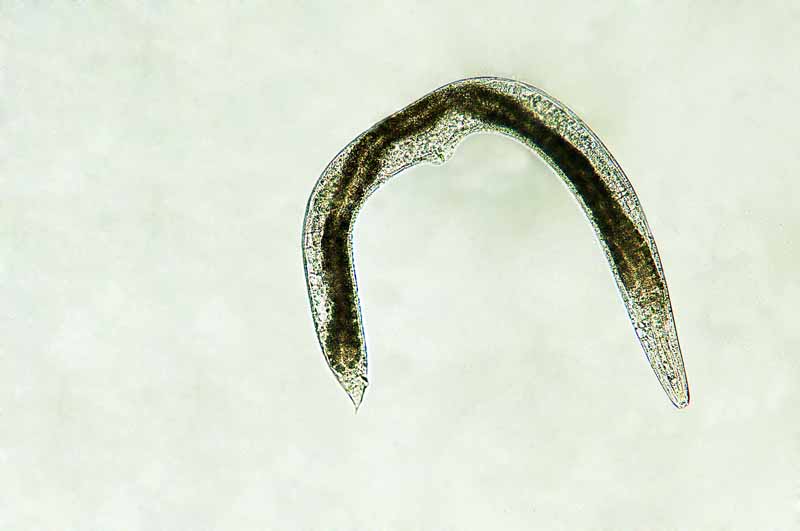
While we are focusing on soilborne insects, insecticidal nematodes are sometimes applied to plants above the ground as well – to eradicate leafminers in plant tissue, for example.
Identify the pest or pests you’d like to kill, and evaluate based on the behavior of each species we’ve talked about.
For example, is your target pest a shallow-dweller or a deep diver? What temperature is the soil where your target pest is living? Is the soil compact or sandy?
The size of the area that you will be treating affects the number of nematodes you will need to purchase. For example, you would buy 5 million of them to treat 1,600 square feet of land, and 50 million to treat an acre.
If your plants are growing in containers or a greenhouse, you may need to apply higher numbers.
Nematodes are very sensitive to UV light, so you should apply them in the morning or evening to avoid direct sunlight.
Applying in the evening is particularly important in the summer when the surface of the soil could be too hot for them to survive. Soil temperatures will be lower at dusk.
A list of many of the insects controlled by commonly sold species follows, but this is by no means a complete compilation.
| Steinernema feltiae controls: | Steinernema carpocapsae controls: | Heterorhabditis bacteriophora controls: |
|---|---|---|
| Beet Armyworm | Armyworm | Ants (Queen) |
| Black Cutworm | Artichoke Plume Moth | Asparagus Beetle |
| Cabbage Maggot | Beet Armyworm | Banana Moth |
| Codling Moth | Black Cutworm | Banana Weevil |
| Corn Earworm | Black Vine Weevil | Berry Root Weevil |
| Cucumber beetles | Bluegrass Weevil | Billbug |
| Crane Flies | Caterpillars | Black Vine Weevil |
| Flea Beetles | Cockroaches | Borers (Iris, Tree, Vine) |
| Fruit Flies | Corn Earworm | Carrot Weevil |
| Fungus Gnats | Cotton Bollworm | Chafers (European, Masked) |
| Leaf Miners | Cranberry Girdler | Citrus Root Weevil |
| Humpbacked Flies | Cucumber Beetle | Colorado Potato Beetle |
| Onion Maggots | Cutworm | Corn Rootworm |
| Plant Parasitic Nematodes | Fall Armyworm | Cranberry Root Weevil |
| Plum Curculio | Flea Larvae | Cucumber Beetle (Spotted) |
| Raspberry Crown Borer | Fly Larvae | Flea Beetles |
| Root Aphids | Fruit Flies | Gall Midges |
| Sclarids | Greater Peach Tree Borer | Grape Root Borer |
| Shore Flies | Lesser Peach Tree Borer | Grubs |
| Subterranean Termites | Large Pine Weevil | Humpbacked Flies/Phorid Flies |
| Sweet Potato Weevil | Leaf Miners | Japanese Beetle |
| Thrips | Mint Flea Beetle | Leaf Miners |
| Ticks | Mint Root Borer | May/June Bugs |
| Tobacco Cutworm | Mole Crickets | Root Weevils |
| White Grubs | Navel Orangeworm | Scarabs |
| Plum Curculio | Strawberry Root Weevil | Sugarcane Stalk Borer |
| Tobacco Budworm | Sweet Potato Weevil | |
| Webworm | Ticks | |
| Wireworm | ||
| Wood Borer |
After answering these questions, you will have a more clear idea of which nematode species to select.
Personal Protective Equipment (PPE) Is Not Required
Applying these beneficial organisms to your garden is simple. No major protective gear is required.
If you prefer a little distance, you can wear gloves, but it’s not essential. These organisms are even safer to use than Bt and pose no risk of toxicity.
How Do They Look When They Arrive?
You will usually receive your nematodes in the form of a gel, clay, dry granules, or water-filled sponges. All of these forms will dissolve in water. Just follow the package directions.
If you require organic certification, you should be aware that nematodes shipped in granules or clay may not be certified organic.
And don’t be alarmed if you receive a bag of dead insects! Beneficial nematodes are frequently sold while they are inside their insect hosts. Wax mealworms are a common source of commercially available insecticidal nematodes.
In this case, you just scatter them on the ground where you want them to act, and the juveniles will emerge.
Timing
Apply when the time is right. Make sure to do your homework and find the target pest so that those beneficial nematodes have something to eat.
The best time to apply is in the spring or fall, when most of the insects you’ll be targeting are in their larval stage. You want to focus on the larvae because they are still in the soil and therefore vulnerable to attack.
For example, fall is the best time to control white grubs like weevil larvae.
If you’re in doubt about the life cycle of your target pest, you can always reach out to your local extension agency and ask for more information on the specific pest in question.
Compatibility with Garden Chemicals
Surprisingly, juvenile insecticidal nematodes are compatible with many types of garden chemicals. They can even be tank-mixed with most fungicides and herbicides.
Fertilizers are typically not a problem, unless you are using fresh manure or high concentrations of chemical fertilizers like urea.
These organisms can even tolerate many insecticides, like organophosphates such as diazinon, although the common insecticide carbaryl (Sevin) is moderately toxic.
You can wait one to two weeks to apply your insecticidal nematodes if you are not sure if your selected chemical insecticide is compatible with these organisms.
Package labels will typically provide the information you need to know regarding which chemicals your chosen species is compatible with.
Irrigation: Keep the Soil Moist
Pay attention to the moisture content of your soil. It is a good idea to thoroughly water it before you apply.
After application, go ahead and water again to rinse any nematodes off the leaves of plants in the area, and down into the soil closer to their targets.
This is particularly important if you are treating turf with a white grub problem. The thick thatch can make it difficult for the nematodes to penetrate the soil.
Watering after application will help the organisms travel through the thatch to get down to the soil where the grubs are.
Once you’ve applied them, you want to keep your soil moist for the next couple of weeks to make sure they can stay active and keep killing those pesky insect larvae! If it doesn’t rain, you should water every three to four days.
How to Physically Apply
To apply the nematodes, you can use a watering can if you are targeting a small area. For larger areas, you can use a pump sprayer, end-hose sprayer, irrigation system, backpack sprayer, or motorized sprayer.
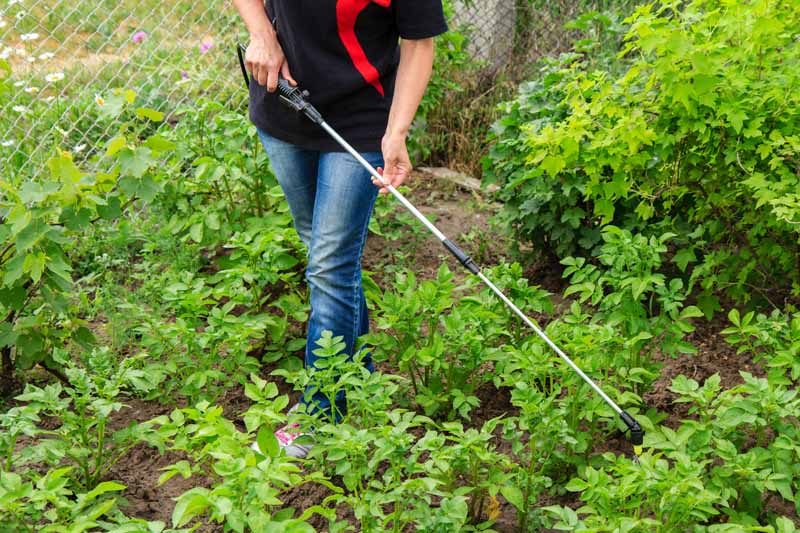
The easiest way to apply them is by using a hose end sprayer that controls the dose applied.
Make sure to agitate the mix of beneficial nematodes and water so that they are evenly dispersed from whatever sprayer you are using. The nematodes have a tendency to settle if they are not mixed properly.
One note of caution: be careful if you use a hydraulic pump with high internal and shear forces. They can shred your nematodes!
You can expect to see results within two weeks.
Reapplication
After the initial application, you should apply again in seven to 10 days to make sure there are enough insecticidal nematodes to assault the populations of your target insects.

If you still have pests, keep applying the organisms every seven to 10 days until the pest populations dwindle.
Remember that if you have a population of insects that has built up over the course of years, it is likely to take more than one application to contain them.
The likelihood of your nematodes surviving the winter depends on your climate. They can typically survive one hard freeze. However, prolonged hard freezes can kill them.
Even if you live in a mild climate, you should reapply a newly purchased batch of nematodes in the spring. You will need a high population of them present to effectively attack your pests.
Storage
The amount of time that the nematodes can be stored varies according to the species. S. carpocapsae survives well in a dessicated state and can be stored for several months at room temperature. However, other types such as H. indica have a shorter shelf life.
Your nematodes should be shipped to you in an insulated container. Typically, they can be stored in the refrigerator for several weeks or even months. Since they are sensitive to extreme temperatures, make sure they don’t freeze.
And keep them away from high temperatures! Temperatures over 90°F will kill most insecticidal nematodes, so be sure not to leave them in a hot vehicle or sunny spot.
Where to Buy
You can often find packages of beneficial nematodes at your local garden center or plant nursery.
Alternatively, there are a variety of online sources as well. Many of these will be listed under a brand name, so you’ll need to check the specific species before purchase.
Steinernema carpocapsae
S. carpocapsae is available as NemAttack™ Sc or BioLogic Sc.
You can find NemAttack™ Sc in packages of 5 million to 500 million available at Arbico Organics.
Biologic Sc is available in packages of 5 million to 25 million via Amazon.
Steinernema feltiae
Steinernema feltiae is available as NemAttack Sf or Biologic Sf.

You can find Biologic Sf in packages of 5 to 25 million available from Biologic via Amazon.
Arbico Organics carries packages of NemAttack™ Sf containing 5 to 500 million nematodes.
Steinernema riobrave
Steinernema riobrave is sold as NemAttack™ Sr.
Find packages containing 5 million S. riobrave available at Arbico Organics.
Heterorhabditis bacteriophora
Heterorhabditis bacteriophora is sold under the brand name NemaSeek™ Hb.
Pick up packages of 5 million to 500 million from Arbico Organics.
Heterorhabditis indica
NemaSeek™ Hi contains the species Heterorhabditis indica.
Find packages containing 5 million available from Arbico Organics.
Get Growing with Nematodes
Beneficial nematodes can offer your home garden immense perks.
You have a wealth of choices available, which will let you target the pests you want to control, while accounting for your type of soil and the ambient soil temperature.
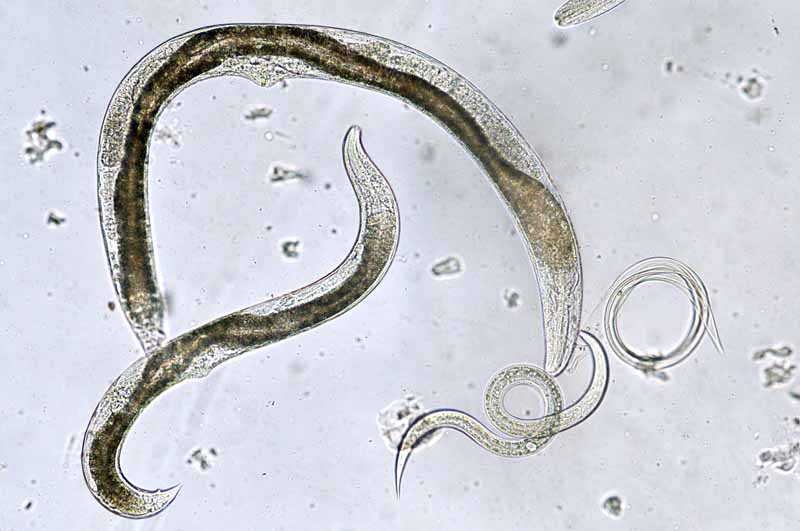
These wonderful little organisms offer great protection for your gardening spaces and are totally safe for use in proximity to humans, other animals, and even beneficial insects.
Now that you know how they operate, add them to your garden, and watch your pests dissipate!
Have you used insecticidal nematodes in your garden? If so, tell us about your experience in the comments.
And for more information on controlling pests in your garden, check out these guides next:
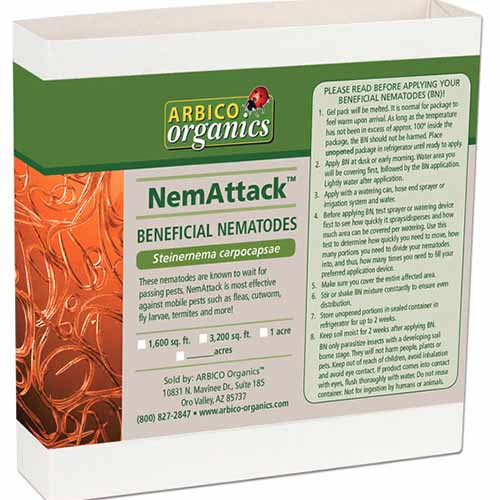
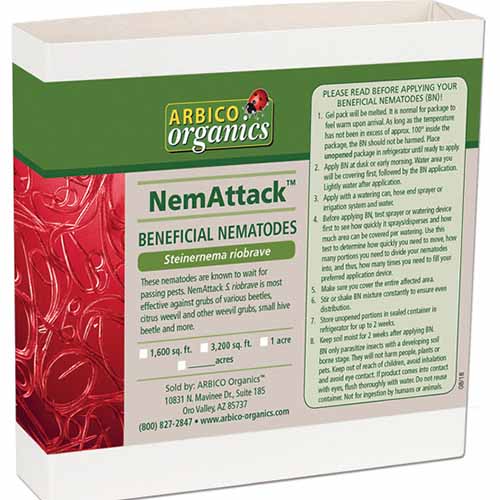
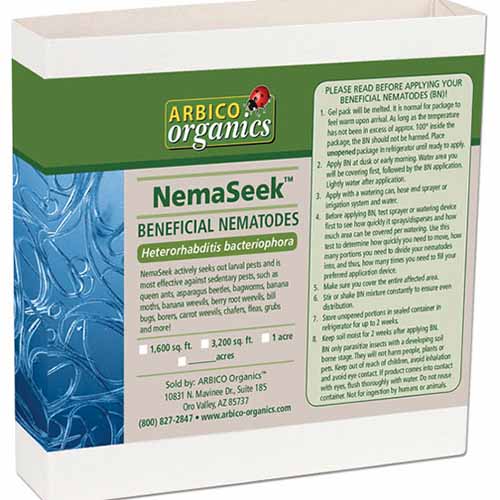
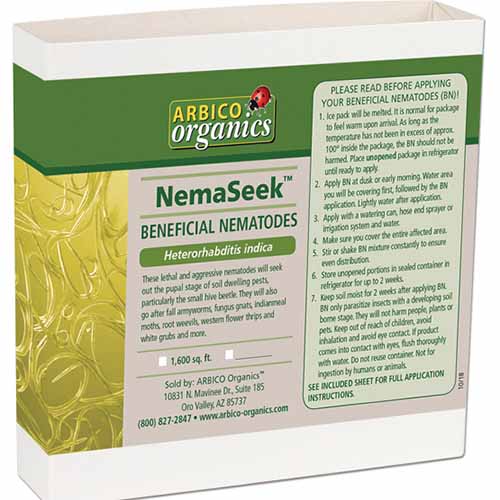
I always thought they were bad!! Are there bad ones? I was told not to plant tomatoes in the ground here in SWFL, because they eat the roots? I’m confused now, thanks.
Hi Cindy, their like many other critters (i.e. beetles), some types are good and some types are bad. The ones you are referring to are root-knot nematodes which are plant-parasites and are distant cousins of the beneficial insect-parasitic worms covered here.
Cindy, their like many other critters (i.e. beetles), some types are good and some types are bad. The ones you are referring to are root-knot nematodes which are plant-parasites and are distant cousins of the beneficial insect-parasitic worms covered here.
Thanks for responding! Is there a way to get rid of these bad ones,or do I continue to plant only in pots?
You’ll need to pull up and destroy infested plants, paying particular attention to getting all of the roots out of there. Depending on your location, one of the best ways to get rid of them is to expose root-knot nematodes to extreme heat or cold. Till and turn the soil periodically in the hot weather, and through the winter after the first frost date in your area. Wait to apply beneficials until the return of warm weather, and don’t plant anything new in the area until you’re sure they’re gone. We’ll cover this topic in more detail in a future… Read more »
Hi! These critters are currently feeding in the roots of my new plants. I believe they are wire worms. Can u tell me if using beneficial nematodes at this stage will eradicate them?
Alexis, I really enjoyed your well written article. This year the Japanese bettles have damaged my Christmas fir trees. The blue birds, phoebes and swallows have been doing their best but I guess they can only eat so many. I didn’t want to use pesticides so thanks again.????
Hi. I have too many beetle like insects in my finished compost too but along with those I see this slender worms. Have attached the one I see in my compost. Can you please tell me if this is a beneficial nematode? Because sometimes I see these coming out of those beetle like insects.
Ok everywhere it says it’s not visible to the naked eye so these are definitely not beneficial nematodes but I want to know what they are. Also can I use beneficial nematodes in my compost to fix this issue?
Beetles and their larvae (aka grubs) are common in compost, and they like to feed on food scraps. But some species can cause problems if you transfer them from the compost pile to your garden, where they might be just as happy to munch on your plants. Bugs like these usually aren’t as attracted to finished compost as they are to large, fresh food scraps and other high-carbon materials. Make sure you’re turning your compost pile regularly, maintaining the moisture level correctly (i.e. not letting it get too wet), and adding a suitable amount of nitrogen-rich materials for balance. Beneficial… Read more »
I thought you were going to mention where we could buy nematodes?
Hi Cin, depending on what type you need, you can find a number of different beneficial nematodes available at Arbico Organics.
I need to eradicate white & brown grubs. I want to try nematodes shifting from Milky Spores. Please let me know where I could buy real live Nematodes effective for white & brown grubs.
It should include instruction on proper use of it. The seller should be highly reputable in selling live Nematodes.
Thank you
Hi Carlo,
We have a guide to dealing with grubs, and recommend using Heterorhabditis bacteriophora species of nematodes. You can purchase these via Arbico Organics under the brand name NemaSeek.
Good luck eradicating your pests!
I enjoyed reading your article. I would like to use beneficial nematodes on my lawns, one in Connecticut and one on Martha’s Vineyard, Massachusetts. My main concerns are ticks, fleas, and grubs. Which nematodes to purchase? I have two little dogs and do not want to use insecticides on the lawn and want to be sure nematodes are very safe for the dogs? Also where to purchase? Thank you so much for any help you can shed on this.
Hi Darlene, sounds like you need to get your hands on Heterorhabditis bacteriophora. This nematode species will address all of the pests you mentioned. And yes, it is safe to use around your pups.
You can grab some at Arbico Organics in several different amounts: https://www.arbico-organics.com/product/nemaseek-beneficial-nematodes-hb-heterorhabditis-bacteriophora?a=2017
loved your article. My nematodes arrived today from Fed Ex and the ice was melted and the package was HOT. Are they still alive? Or am I wasting time using them?
Oh, dear. It’s possible that they’re still alive as they can survive up to 100°F or so, but depending on how long they were hot and just how hot it got, they might be dead.
I live in Utah on a farm and I am looking for nematodes that will help with dairy flies ,stable flies, house flies, mosquitoes, gnats. It gets cold here – this week it was -12 at my house at night. I’ve been told I could apply them when it gets warmer, but I’m looking for info and help. Thank you.
Hi Bob, from a former Utahn. It sounds like you want to control a range of species, which you can absolutely do with beneficial nematodes. To kill off the juvenile forms of a huge range of mosquitos, flies, and gnats, use nematodes in the Heterorhabditis and Steinernema genera. Arbico Organics makes a product called NemAttack, which includes three different species of nematodes: Heterorhabditis bacteriaphora, Steinernema carpocapsae and Steinernema feltiae. Follow the manufacturer’s directions closely, but essentially, you want to mix the nematodes with water and spray the soil where the insects are most likely to breed. You need to wait… Read more »
Hi. I am new here. I started an indoor garden and it going well until I started having tons of gnats now. I am using BT but am thinking of using Nematodes. How long do I have to wait after applying BT before I can use the Nematodes? I appreciate any help. Thanks.
Bti can be used to kill fungus gnat larvae, but note that this is a different subspecies than the variety of Bt used to address caterpillar pests on foliage. Unfortunately Bt is also toxic to nematodes. See our guide to controlling fungus gnats on houseplants. Steinonerma feltiae nematodes should do the trick, but Bt can persist in soil for up to six months.